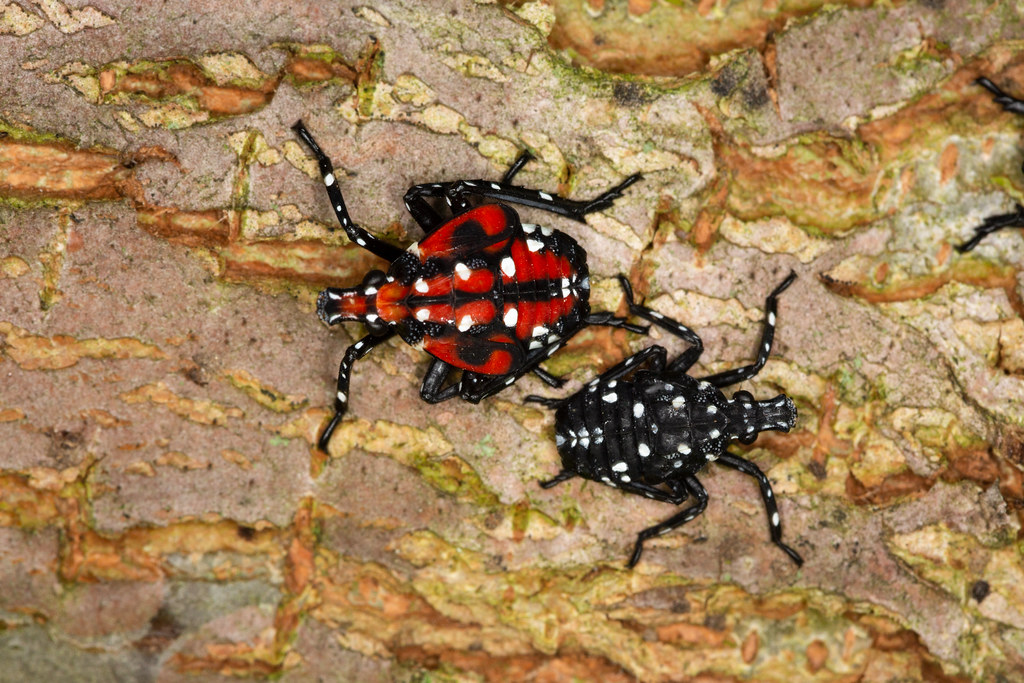Spotted Lantern Fly

The Spotted Lanternfly, Lycorma delicatula (White) is native to China, India, Vietnam, and introduced to Korea where it has become a major pest. It was first detected in Pennsylvania in 2014. This insect has the potential to greatly impact the grape, hopes, and logging industries. As of May 2020, 26 Pennsyvania Counties are under quarantine for spotted lanternfly.
Identification:
The Spotted Lanternfly adult is approximately 1" long and 1/2" wide at rest. The forewing is grey with black spots and the wings tips are reticulated black blocks outlined in grey. The hind wings have contrasting patches of red and black with a white band. The legs and head are black; the abdomen is yellow with broad black bands. Immature stages are black with white spots, and develop red patches as they grow.
Early (Black and White) and Late (Red, Black and White) Nymph Stages
Signs & Symptoms:
Trees, such as tree of heaven and willow, will develop weeping wounds. These wounds will leave a greyish or black trail along the trunk. This sap will attract other insects to feed, notably wasps and ants. In late fall, adults will lay egg masses on host trees and nearby smooth surfaces like stone, outdoor furniture, vehicles, and structures. Newly laid egg masses have a grey mud-like covering which can take on a dry cracked appearance over time. Old egg masses appear as rows of 30-50 brownish seed-like deposits in 4-7 columns on the trunk, roughly an inch long.
Follow these simple steps to help stop the spread:
1. Check your belongings when travelling.
Always inspect your vehicle and any items you are taking with you for all stages of the spotted lanternfly, including egg masses, nymphs, and adults. Avoid travelling with firewood.
2. Scrape and destroy egg masses.
From September - May, if you see egg masses, scrape them off, double bag them and throw them away. You can also place the eggs into alcohol or hand sanitizer to kill them.
3. Use Tree Traps
Banding trees is most effective for the nymph stage. Sticky bands should be caged to prevent birds and other mammals from becoming trapped.
4. Remove Host Plants
Tree of Heaven (Ailanthus altissima) is an invasive plant and preferred host tree for spotted lanternflies. Penn State Extension recommends applying herbicide to the tree from July - September, then waiting at least 30 days before removing the tree. For more information on how to identify Tree of Heaven, please visit the Penn State Extension Spotted Lanternfly website.
5. Apply Insecticides
Home gardeners are advised to use soil drenches, bark sprays or direct sprays to combat spotted lanternfly. Be sure to follow the label for directions, application rates, methods, and appropriate protective equipment. We recommend Bonide Tree and Shrub Drench. For more information, please visit our garden centers.
Reporting Spotted Lanternfly:
Please report all destroyed egg masses online. If you live outside of the current (quarantine area) in Pennsylvania and find a spotted lanternfly, report it! Use this interactive Plant Pest Quarantine Search to see if you're in the spotted lanternfly quarantine area.
For even more information, check out this PDF on the Spotted Lanternfly created by the United States Department of Agriculture.
The article was originally published by the Pennsylvania Department of Agriculture. For more information, please visit the Penn State Extension's Spotted Lanternfly Management Guide for Homeowners.
